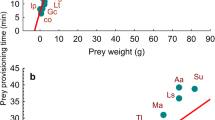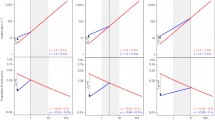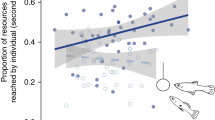Summary
Food density, degree of hunger prior to foraging, and food processing difficulty were varied in order to determine their effects on the diet diversity of captive Peromyscus leucopus foraging for buried seeds. No relationship was found between diet diversity and food density. However, diet diversity exhibited a significantly positive relationship with hunger, and a significantly negative relationship with seed processing time. These results strongly support optimal foraging theory.
Similar content being viewed by others
References
Charnov EL (1976) Optimal foraging: the attack strategy of a mantid. Am Nat 110:141–151
Chew LR, (1992) Some factors influencing the distribution of the prairie vole, forest deer mouse, and prairie deer mouse. Ecology 3:29–47
Dice RM (1951) The water exchanges of some small mammals. Ecol Monogr 21:215–225
Ebersole JP (1977) Experiments on optimal foraging in Peromyscus. In: Crowder L ed, Ecological Lab Experiences, An Ideas Forum. Michigan State University, Dept of Zoology, p 69–78
Emlen JM (1966) The role of time and energy in food preference Am Nat 100:611–617
Emlen JM (1968) Optimal choice in animals. Am Nat 102:385–389
Goss-Custard JD (1977) Optimal foraging and the size selection of worms by redshank Tringa totanus. Anim Behav 25:10–29
Howard WE (1951) Relation between low temperatures and available food to survival of small rodents. J Mammal 32:300–312
Kleiber M (1975) The Fire of Life. John Wiley and Sons, New York
MacArthur RH, Pianka ER (1966) On optimal use of pathy environment. Am Nat 100:603–609
Pulliam HR (1974) On the theory of optimal diets. Am Nat 108:59–74
Pulliam HR (1975) Diet optimization with nutrient constraints. Am Nat 109:765–768
Pyke GH, Pulliam HR, Charnov EL (1977) Optimal foraging: a selective review of theory and tests. Quart Rev Biol 52:137–152
Reichman OJ (1977) Optimization of diets through food preference by heteromyid rodents. Ecology 58:454–457
Reichman OJ, Oberstein D (1977) Selection of seed distribution types by Dipodomys merriami and Perograthus amplus. Ecology 58:636–643
Schoener TW (1969) Optimal size and specialization in constant and fluctuating environments: an energy-time approach. Brookhaven Symp Biol 22:103–114
Schoener TW (1971) Theory of feeding strategies. Ann Rev Ecol Syst 2:369–404
Sealander JA Jr (1952) Food consumption in Peromyscus in relation to air temperature and previous thermal experience. J Mammal 33:206–218
Werner EE Hall DJ (1974) Optimal foraging and size selection of prey by bluegill sunfish (Lepomis machrochirus). Ecology 55:1042–1052
Author information
Authors and Affiliations
Rights and permissions
About this article
Cite this article
Ebersole, J.P., Wilson, J.C. Optimal foraging: The responses of Peromyscus leucopus to experimental changes in processing time and hunger. Oecologia 46, 80–85 (1980). https://doi.org/10.1007/BF00346970
Received:
Issue Date:
DOI: https://doi.org/10.1007/BF00346970




